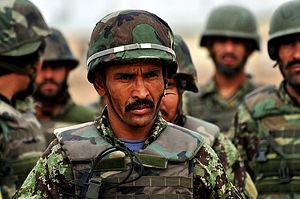I wrote for The Diplomat last week on America’s efforts to speed Afghanistan’s pivot to India. As I stated in that piece, that pivot will not come without consequences for Kabul. With the United States canceling defense contracts and subsidies for the Pakistani military, Pakistan’s Inter-Services Intelligence (ISI) agency is waging a covert war to bloody Kabul, utilizing its “veritable arm,” the Haqqani Network, to achieve its objectives.
Recent events in Afghanistan highlight that the Haqqani Network is currently on the rise in Afghanistan and within the main core of the Taliban itself.
Over the weekend several villages in eastern Afghanistan’s Paktika province were overrun by Taliban militants. Gunmen overtook villages in Omna district, reminiscent of the recent collapse of Jani Khel district in Paktia province. Some reports indicate that the entire district has already collapsed, with 21 Afghan security forces killed or wounded.
Both Paktia and Paktika provinces have deep connections to the Haqqani Network. On June 9, 2016, a senior Haqqani commander, Sirajujdin Khademi, a logistician for Paktika province operations, was killed in a U.S. drone strike. The collapse of these provinces would establish a safe space for Haqqani operations, and the ability to launch deadly bombings and suicide operations in Kabul.
Historically, Paktika province has served as a staging ground for operations against Kabul. After the deadly 2011 attack on Kabul’s Intercontinental Hotel, NATO launched a larger scale operation to destroy a Haqqani training camp suspected of organizing the deadly terror act.
“The encampment site was a staging area for Haqqani and foreign fighters. These fighters were moved into the country by Haqqani insurgents who planned to use them for attacks throughout Afghanistan,” ISAF said.
The collapse of these strategic districts is a worrisome sign for Kabul as it struggles to push beyond recent divisions between President Ashraf Ghani and CEO Abdullah Abdullah. Attacks in Kabul may further the political divide between the two men — making it ever more difficult to address the economic and security issues plaguing the war torn country.
Furthermore, several recent bombings this year have already been attributed to the Haqqani Network, highlighting the terror group’s extensive and sophisticated network and capabilities. The attack on the American University of Afghanistan (AUAF) this August that killed 16 and injured 53 was loosely attributed to Haqqani after Ghani phoned the Pakistani Army chief, Gen. Raheel Sharif, and “asked for serious and practical measures against the terrorists organizing the attack.”
The unprecedented attack on the Kabul based university has also raised interesting questions on the current state and structure of the Taliban. Though attacks on rural school systems have been a common modus operandi for Taliban fighters, high profile attacks in urban areas on school systems such as the university in Kabul are largely unheard of.
A week prior to the attack on AUAF, Taliban leaders, in an attempt to reign in various commanders, issued the following statement, “According to the principles of the Islamic Emirate, no mujahid has the permission to destroy a bridge or burn a school… Our countrymen have to be aware that the Islamic Emirate mujahideen never intentionally harm any school or public property. The Emirate’s leadership has repeatedly brought the protection of these institutions to the attention of mujahideen.”
The prohibition of attacks on schools and universities illustrates two possibilities with regards to the inner workings of the Taliban. The first possibility is that fanatics and extremists such as the Haqqani Network have gained an extensive voice within the network; as evidence, Sirajuddin Haqqani, de facto leader of the Haqqani Network, has been described as the main day to day driver of the Taliban’s military operations. This position is further bolstered by the attack carried out by the Haqqani and publicly supported by the core of the Taliban on Tolo News in January that killed seven.
The second possibility is that powerful decentralized groups are carrying out attacks not supported by mainstream elements of the Taliban, or these attacks are designed to provide the central command of the Taliban deniability.
Either way, the Haqqani Network is gaining sway within the main element of the Taliban, and the driving force behind the Haqqani is the Pakistani ISI. In 2011, Admiral Mike Mullen, before the Senate Armed Services Committee stated, “The Haqqani Network, for one, acts as a veritable arm of Pakistan’s Inter-Services Intelligence agency.” With the United States pushing Afghanistan closer to India, Pakistan feels it has no recourse but to prop up its proxy elements in the beleaguered nation.
Attempting to punish Pakistan for its support of the Haqqani Network, U.S. Secretary of Defense Ashton Carter refused to provide testimony before Congress that Pakistan had fulfilled its obligation to fight terror groups within the country, denying Pakistan $300 million in subsidies from the U.S. government, which the Pakistani government relies on for a quarter of its $4 billion military budget.
With three bombings reported in Kabul Monday, two at the Ministry of Defense, and one targeting a guest house, these scenes may become all more common as Pakistan reacts to Kabul’s pivot to India. The collapse of two strategic districts in eastern Afghanistan vital to Haqqani indicates Pakistan is prepping its proxies to undermine U.S. and Indian efforts at rebuilding and defending the war torn nation.

































